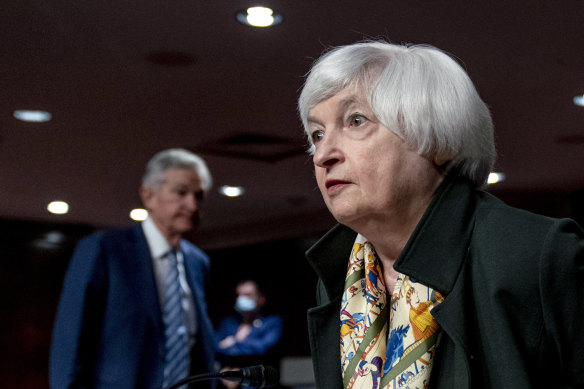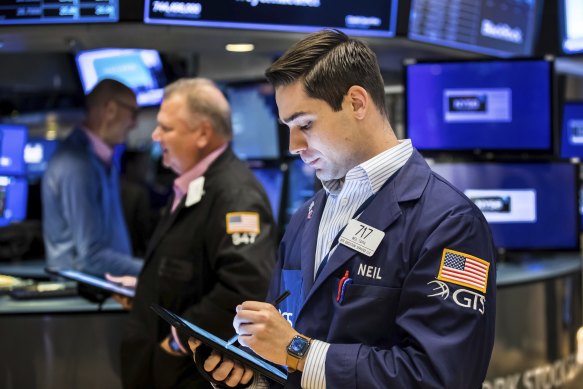- Updated
- Business
- Markets
- World markets
This was published 2 years ago
ASX closes 0.7 per cent lower as Wall Street rattled by Powell, Yellen
By Jessica Yun and Colin Kruger
The Australian sharemarket is on track for its seventh week of losses after finishing in the red on Thursday following more volatility on Wall Street. US losses were triggered by Federal Reserve chairman Jerome Powell flagging yet more rate rises to fight inflation and mixed messages from Treasury Secretary Janet Yellen on protecting bank deposits.
The S&P/ASX 200 closed down 47 points, or 0.7 per cent, at 6968.6 points, with falls in the global-growth dependent mining heavyweights weighing on the market. BHP shed 0.8 per cent, Rio Tinto dropped 1.1 per cent and Fortescue Metals Group losing 3.3 per cent.

Treasury Secretary Janet Yellen and Jerome Powell’s differing statements on the safety of bank deposits confused investors.Credit: AP
Banking stocks also weakened, following their peers in the US lower, with all big four banks in the red. Commonwealth Bank slipped 0.1 per cent, NAB slid 1.5 per cent, ANZ lost 0.4 per cent and Westpac was 0.5 per cent lower at the end of the day. “Millionaires’ factory” Macquarie Group fell 1.8 per cent.
Software-defined network service provider Megaport was the day’s biggest loser, down 8.5 per cent, followed by Lake Resources and Sayona Mining, which slid 8.1 per cent and 7.5 per cent respectively.
The day’s best performer was United Malt Group, up 5.5 per cent, followed by Brickworks and GUD Holdings, which lifted 3.1 per cent and 2.5 per cent. Brickworks’ share price gained after the company reported a record half-year underlying profit of $410 million, even though it warned of a slowdown in demand for its building products before the end of 2023.
Pharma company Sigma Healthcare, which owns the Amcal and Discount Drug Store chains, finished 0.8 per cent higher after swinging to a narrow profit, but predicted interest rate rises to continue to hamstring consumer spending.
Wall Street roller-coaster
Overall, the local index’s dreary performance was a reflection of investor concerns on Wall Street.
Investors there were just recovering in afternoon trade from the Fed’s decision to raise interest rates 25 basis points as Fed chief Powell held his press conference, tipping broader protection to depositors should financial stress in the banking sector spread. Sentiment changed dramatically when Yellen knocked that hope down, telling Congress that regulators aren’t looking to provide “blanket” deposit insurance to stabilise the US banking system, and that the heads of recently failed American lenders should be held accountable.
“I have not considered or discussed anything having to do with blanket insurance or guarantees of deposits,” Yellen said during a hearing before a Senate subcommittee, answering a question about whether the protections would be provided to all US deposits.
The contradictory comments led the S&P 500 to shed 1.7 per cent, erasing an earlier gain of 0.9 per cent. The Dow Jones lost 1.6 per cent, while the Nasdaq composite dropped 1.6 per cent.
“It’s astounding that Yellen and Powell would have given contradictory messages on bank deposits at the same time,” said Steve Chiavarone, senior portfolio manager and head of multi-asset solutions at Federated Hermes. “Powell essentially said that all deposits are safe, Yellen said, ‘Hold my beer.’ You would have thought that they would have co-ordinated.”
Many economists aren’t convinced the US Federal Reserve’s move to hike rates was conducive to steadying financial stability.
“As the crisis in the banking system continues to unfold, we believe the likelihood of a hard landing scenario – our base case for some time – has risen dramatically in recent days,” said Fidelity International global economist Anna Stupnytska.
Barclays’ economics research team also pointed out that Powell himself acknowledged the recent banking crisis would result in tighter credit conditions, which would weigh on labour market demand and inflation.

Wall Street see-sawed after the Fed announcement.Credit: AP
Economists are now starting to see a higher risk of a recession occurring later this year.
The Fed raised its key overnight rate by a quarter of a percentage point, the same size as its last increase, in its campaign to drive down inflation. The move was exactly what Wall Street has been expecting. The bigger question was where the Fed is heading next. There, the Fed gave a hint it may not hike rates much more as it assesses the fallout from the crisis hitting the banking industry.
The Fed also released the latest set of projections from its policymakers on where rates are heading in upcoming years. The median forecast had the federal funds rate sitting at 5.1 per cent at the end of this year, up only a smidge from where it currently sits, in a range of 4.75 per cent to 5 per cent.
That’s the same level as seen in December, and it’s counter to worries in the market that it could rise given how stubborn high inflation has remained. That helped to send yields slumping in the bond market, which has been home to some of the wildest action this month.
The Fed was stuck with a difficult decision as it balanced whether to keep hiking rates to drive down inflation or ease off the increases given the pain it’s already caused for the banking industry, which could drag down the rest of the economy. The second- and third-largest US bank failures in history have both occurred in the past two weeks.
with Bloomberg, AP
The Market Recap newsletter is a wrap of the day’s trading. Get it each weekday afternoon.